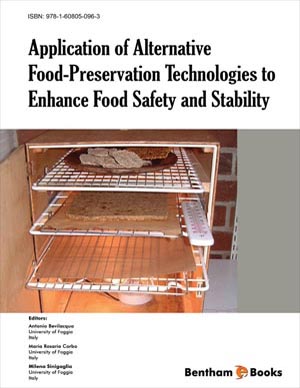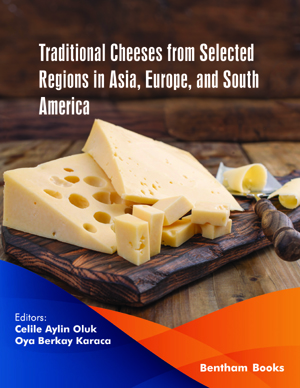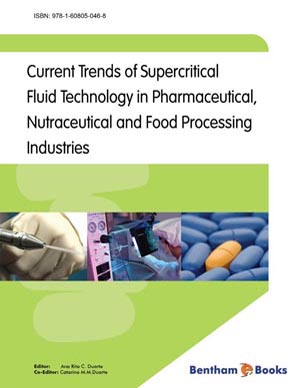Foreword
Page: i-i (1)
Author: Antonio Bevilacqua, Maria Rosaria Corbo and Milena Sinigaglia
DOI: 10.2174/97816080509631100101000i
Preface
Page: ii-ii (1)
Author: Antonio Bevilacqua, Maria Rosaria Corbo and Milena Sinigaglia
DOI: 10.2174/9781608050963110010100ii
Contributors
Page: iii-iv (2)
Author: Antonio Bevilacqua, Maria Rosaria Corbo and Milena Sinigaglia
DOI: 10.2174/978160805096311001010iii
Abstract
Full text available
Green Consumerism and Alternative Approaches for Food Preservation: an Introduction
Page: 1-3 (3)
Author: Antonio Bevilacqua, Maria Rosaria Corbo and Milena Sinigaglia
DOI: 10.2174/978160805096311001010001
PDF Price: $30
Abstract
Consumer awareness towards the use of natural compounds has increased significantly since the beginning of 1990s and new trend has arisen in food industry, i.e. the green consumerism.
The green consumerism is the basis for the development of alternative approaches for food preservation, like the use of natural compounds (essential oils, lysozyme, nisin and other bacteriocins, chitosan) and nonthermal treatments (high hydrostatic pressures, homogenization, microwave, irradiation).
These new technologies are the topics of this e-book; this chapter offers an introduction to the entire work.
Risk Assessment and Food Safety Objectives
Page: 4-16 (13)
Author: Antonio Bevilacqua, Barbara Speranza and Milena Sinigaglia
DOI: 10.2174/978160805096311001010004
PDF Price: $30
Abstract
Foodborne diseases are a global threat both in Developing and Industrialized Countries thus forcing Public Agencies to define some key-concepts for a correct management of the risk associated with foods. Food producers have always used an empirical approach; however, a new way of risk management and definition has been proposed since 1995 and labeled as Quantitative Risk Analysis (QRA). QRA is a 3-step process (risk management, risk analysis/assessment, risk communication) and results in the definition of some Public Goals, labeled as ALOP (Appropriate Level of Protection) and FSO (Food Safety Objectives), along with some intermediate parameters (performance objectives and criteria, process criteria), useful to maintain the risk below a certain threshold.
The chapter proposes a brief description of the main steps of QRA, along with some-key concepts to define microbiological criteria for foods.
Food Spoilage and Safety: Some Key-concepts
Page: 17-34 (18)
Author: Barbara Speranza, Antonio Bevilacqua and Milena Sinigaglia
DOI: 10.2174/978160805096311001010017
PDF Price: $30
Abstract
Several mechanisms cause deterioration of food and limit their shelf life: biochemical or microbial decay, chemical changes - especially oxidation (rancidity of fats, respiration of fruits and vegetables, discoloration, vitamin loss) -, physical deterioration (moisture migration, water loss or uptake). Therefore, food spoilage is a complex phenomenon, involving physical, chemical, microbiological and biochemical changes. As all involved factors and mechanisms operate interactively and often unpredictably, it is very difficult to predict shelf life of food products precisely. In addition, due to the high diversity of food products, there is no standard method for determining shelf life.
The sections of this chapter try to supply some key-concepts about food spoilage and food safety with a particular focusing on the microbiological aspects. A brief synopsis of the bacterial pathogens mostly involved with foodborne outbreaks and of the main spoiling microflora of foods is given. As there are several ways to detect microbial spoilage in foods, - i.e. the microbiological methods, chemical/physical/physiochemical methods, acceptability criteria, including sensory determinations (color, texture, odor, flavor and general appearance)-, some details for each kind of approach are reported.
Essential Oils for Preserving Perishable Foods: Possibilities and Limitations
Page: 35-57 (23)
Author: Barbara Speranza and Maria Rosaria Corbo
DOI: 10.2174/978160805096311001010035
PDF Price: $30
Abstract
Since the middle ages, essential oils (EOs) have been widely used for bactericidal, virucidal, fungicidal, antiparasitical, insecticidal, medicinal and cosmetic applications. Nowadays, it is well known that EOs can enhance the shelf life of unprocessed or processed foods because of their antimicrobial nature. Nevertheless, very few preservation methods based on EOs utilization are implemented until now by the food industry.
The aims of this chapter are: 1) to make an overview of the current knowledge on the antibacterial activity of EOs; 2) to describe their possible modes of action; 3) to evaluate possibilities and limitations of their use in the food industry.
In vitro studies have demonstrated antibacterial activity of EOs against a wide range of spoilage and pathogenic bacteria. As EOs comprise a large number of components, it is likely that their mode of action involves several targets in the bacterial cell, but it is generally recognized that their hydrophobicity enables them to partition in the lipids of the cell membrane and mitochondria, rendering these membranes permeable and leading to leakage of cell contents. A higher concentration is generally needed to achieve the same effect in foods, but studies with meat, fish, milk, dairy products, vegetables and fruits have shown promising results at very low concentrations of EOs (<0.5%, v/w). Toxicological data do not appear to raise concern in view of their current levels of use in foods.
Enzymes and Enzymatic Systems as Natural Antimicrobials
Page: 58-82 (25)
Author: Daniela D’Amato, Daniela Campaniello and Milena Sinigaglia
DOI: 10.2174/978160805096311001010058
PDF Price: $30
Abstract
Lysozyme is a hydrolytic enzyme which has been purified from cells, secretions and tissues of virtually all living organisms and viruses. Lysozyme has been shown to have antimicrobial activities towards bacteria, fungi, protozoan and viruses; moreover, it is essentially known for its antibacterial activity and has been used in food preservation. Lysozyme is currently used as a preservative in many foods, such as cheese, fish, meat, fruit, vegetables and wine.
Lactoferrin is a globular multifunctional protein with antimicrobial activity. It is produced by mucosal epithelial cells in various mammalian species. It is found in mucosal surfaces and in biological fluids, including milk and saliva. It possesses a strong antimicrobial activity against a broad spectrum of bacteria, fungi, yeasts, viruses and parasites. Lactoferrin is used in a wide range of products including infant formulae, sport and functional foods.
The lactoperoxidase system (LPS) consists of three components: enzyme lactoperoxidase, thiocyanate and hydrogen peroxide. LPS exerts both bacteriostatic and/or bactericidal activity; therefore, its use in dairy industry to preserve raw milk quality or to extend the shelf life of pasteurized milk has been extensively proposed in the past. LPS has also been used the stabilization cream, cheese, liquid whole eggs, ice cream, infant formula and for the preservation of tomato juice, mangoes and chicken.
Antimicrobial Agents of Microbial Origin : Nisin
Page: 83-91 (9)
Author: Daniela D’Amato and Milena Sinigaglia
DOI: 10.2174/978160805096311001010083
PDF Price: $30
Abstract
Nisin belongs to a group of bacteriocins known as “lantibiotics”, small peptides produced by Gram-positive bacteria of different genera. Nisin consists of 34 amino acids and is the only commercially accepted bacteriocin for food preservation; it is produced by certain strains of Lactococcus lactis subsp. lactis. Nisin is a natural, toxicologically safe, antibacterial food preservative, characterized by an antimicrobial activity against a wide range of Gram-positive bacteria, but not against Gram-negative bacteria, yeasts or fungi. It can act against Gram-negative bacteria, in conjunction with chemically induced damage of the outer membrane. Nisin was labeled as GRAS (generally recognized as safe) in 1988 by FDA, and is currently permitted as a food additive in over 50 countries around the world.
Nisin has found practical application as a natural food preservative in many categories of food, such as natural cheese (Emmental and Gouda), processed cheese (slices, spread, sauces and dips), pasteurized dairy products (milk, chilled desserts, clotted cream and mascarpone cheese), egg products, hot baked flour products (crupets), canned products, alcoholic beverages (beer and wine), salad dressing, meat and fish products, yogurt and pasteurized soups.
Chitosan: a Polysaccharide with Antimicrobial Action
Page: 92-113 (22)
Author: Daniela Campaniello and Maria Rosaria Corbo
DOI: 10.2174/978160805096311001010092
PDF Price: $30
Abstract
At present, discards from the world’s fisheries exceed 20 million tons. Traditionally, fisheries wastes are used in the production of fertilizers, fish silage or pet foods; nowadays with advances in bioprocess engineering technologies and novel enzymatic and microbial hydrolysis methods, processing wastes may serve as cheap raw materials for the generation of high-value bioactive compounds and novel environmental and ecological material derived from marine wastes. In particular, shellfish waste is the main source of biomass for chitin (and its derivatives) production. In this contest chitosan, thanks to its versatility, has found numerous applications as antimicrobial agents, antioxidants, additives, enzyme immobilization and use in the encapsulation of nutraceuticals. In addition, chitosan possesses a film-forming properties for use as edible films or coating. Several researchers studied chitosan, its chemical and physical characteristics and its applications. This chapter is an attempt to summarize these works focused on the following questions: what is chitosan? How does it act against microorganisms and what is its impact on food properties?
Use of High Pressure Processing for Food Preservation
Page: 114-142 (29)
Author: Antonio Bevilacqua, Daniela Campaniello and Milena Sinigaglia
DOI: 10.2174/978160805096311001010114
PDF Price: $30
Abstract
High pressure processing has been proposed since the beginning of the 1900, as a suitable mean for reducing food contamination by pathogens and spoiling microorganisms. It is defined as non-thermal treatment that uses the pressure (300-700 MPa, in some cases up to 1000 MPa) as the main preservation method.
Based on the different ways to achieve pressure increase, we can distinguish between High Hydrostatic Pressure (HHP) and High Pressure Homogenization (HPH); HHP attains pressure rise through a fluid, whereas in HPH treatments pressure increases as a consequence of forcing product through a small valve (homogenizing valve).
Both these approaches have been proposed for different kinds of foods (HHP, for chopped onions, apple sauce and apple sauce/fruit blends as eat-on-to-the-go single serve tubes; HPH, for milk and juices) and currently used in many industrial applications.
The chapter proposes an exhaustive description of both these methods, including the mode of actions against the microorganisms, the modifications on foodstuffs, a possible combination with some other hurdles and some examples of industrial applications.
Finally, in the case of HHP there is a report on its safety and implications on health, based on some publications of Public Agencies.
Alternative Non-Thermal Approaches: Microwave, Ultrasound, Pulsed Electric Fields, Irradiation
Page: 143-160 (18)
Author: Nilde Di Benedetto, Marianne Perricone and Maria Rosaria Corbo
DOI: 10.2174/978160805096311001010143
PDF Price: $30
Abstract
This chapter proposes a description of some non-thermal technologies (microwave, ultrasound, pulsed technologies, irradiation) as suitable tools to inactivate foodborne pathogens and spoiling microorganisms in heat-sensitive foods.
Ultrasound (US) is defined as pressure waves with a frequencies of 20 kHz or more; pulsed electric field (PEF) processing involves treating foods placed between electrodes by high voltage pulses in the order of 20- 80 kV/cm (usually for a couple of microseconds); ionizing irradiation occurs when one or more electrons are removed from the electronic orbital of the atom; and microwaves (MW) are defined as electromagnetic waves in the range of infrared (IR) and radio waves (RF) with a wavelength ranging from 1 mm to 1 m and operating at a frequency ranging from 300 Mhz to 300 Ghz. Each technique allows killing of vegetative microorganisms but fail until now, when applied alone, to destroy spores.
This chapter reports some practical applications of the proposed approaches in food industry and also focuses on their drawbacks and limitations.
Food Shelf Life and Safety: Challenge Tests, Prediction and Mathematical Tools
Page: 161-187 (27)
Author: Antonio Bevilacqua and Milena Sinigaglia
DOI: 10.2174/978160805096311001010161
PDF Price: $30
Abstract
Predictive microbiology (PM) is an interesting tool to predict the survival/growth of pathogens and spoiling microorganisms in foods, as well as a powerful mean for the evaluation of the shelf life and the effects of some hurdles in food industry. This chapter offers an overview of the most important primary models to fit growth (Baranyi, Gompertz and lag-exponential equations) or survival kinetics (the function of Bigelow, along with the equations included in the Add-in-Excel component GInaFiT).
Then, the chapter describes some secondary models used in food microbiology (square root, cardinal, Arrhenius and polynomial equations), as well as a brief synopsis of a new approach, the S/P model, based on the simultaneous evaluation of the microflora growth and the production of an end-product or the consumption of a substrate.
Another interesting tool proposed by the chapter is a summary of the approaches used for the evaluation of the lag phase of a microbial population, along with an appendix reporting some key-concepts of the Design of Experiments and a description of the indices for the evaluation of the goodness of fitting of a function.
Microencapsulation as a New Approach to Protect Active Compounds in Food
Page: 188-195 (8)
Author: Mariangela Gallo and Maria Rosaria Corbo
DOI: 10.2174/978160805096311001010188
PDF Price: $30
Abstract
Microencapsulation has been defined as “the technology of packaging solid, liquid and gaseous active ingredients in small capsules that release their contents at controlled rates over prolonged periods of time”. The production of microcapsules began in 1950s, when Green and Schleicher produced microcapsules dyes by complex coacervation of gelatine and gum Arabic, for the manufacture of carbonless copying paper.
In relation to their structure, the particles can be classified as: mononuclear, polynuclear and matrix type. There are some methods for the microcapsules production; the choice of the microencapsulation method relies both on the nature and characteristics of the polymeric material used and the properties of the active ingredients. The main encapsulation techniques are: emulsion and interfacial polymerization, coacervation, liposome, suspension crosslinking, spray drying, spray cooling, solvent evaporation or extraction.
Firstly proposed in the pharmaceutical industry, today this technique is popular in agriculture, food industry, cosmetic and energy generation. In food industry microencapsulation is used for vitamins, flavors, enzymes and probiotic microorganisms.
Alternative Modified Atmosphere for Fresh Food Packaging
Page: 196-204 (9)
Author: Maria Rosaria Corbo and Antonio Bevilacqua
DOI: 10.2174/978160805096311001010196
PDF Price: $30
Abstract
Modified atmosphere packaging (MAP) has a long history of safe and effective use to prolong the shelf life of foods; it involves the change of gas composition inside the bag, mainly an increase of CO2 content and the lowering of O2.
In recent years, many authors have proposed the use of some non-conventional gases, like argon (Ar) and other noble gases, or the use of volatiles in the head space (hexanal, hexenal, essential oils from citrus) to improve the safety and quality of fresh products.
This appendix offers a short overview of the most recent findings in the application of these novel approaches for food preservation, along with a proposal for some possible ways to improve the use of these methods for an effective scale up in food industry.
Index
Page: 205-207 (3)
Author: Antonio Bevilacqua, Maria Rosaria Corbo and Milena Sinigaglia
DOI: 10.2174/978160805096311001010205
Abstract
Full text available
Introduction
The book covers the applications of some alternative approaches for prolonging food shelf life. The book describes the role of food safety objectives, natural compounds (such as oils and microbial enzymes), pressure and atmospheric techniques and alternative approaches (microwave, irradiation and mathematical microbial modeling) in food preservation. Implications of preservative approaches on food texture and sensorial quality are also discussed along with technology related hurdles commonly encountered in the field. The book should be very useful for food producers and microbiologists.



















